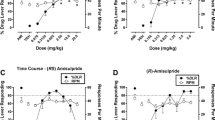Abstract
Male albino rats were trained and tested on a two-lever discrimination task based upon the presence or absence of d-amphetamine (1.0 mg/kg). This compound was found to produce strong discriminative cues (i.e., 90% correct choice behavior). A dose-effect function was then ascertained and the discriminative ED50 (following training with 1.0 mg/kg) was found to be 0.23 mg/kg d-amphetamine.
In order to determine the effective duration of d-amphetamine action, the interval between injection and testing was varied; it was found that the discriminative effects of the drug began to dissipate between 60 and 90 min post-injection.
In an attempt to compare the discriminative cues of other drugs with those of d-amphetamine, injections of LSD (0.04 and 0.08 mg/kg), psilocybin (0.50 and 1.0 mg/kg), THC (0.50 and 1.0 mg/kg), mescaline (5.0 and 10.0 mg/kg), and caffeine (6.0 and 20.0 mg/kg) were given during extinction. In all cases, the rats responded predominantly on the saline-related lever. Only methamphetamine (1.0 mg/kg) produced d-amphetamine-like responding.
Finally, alpha-methyl-para-tyrosine (AMPT), a compound which depletes brain catecholamines (CA), was found to disrupt the d-amphetamine-saline discrimination.
Similar content being viewed by others
References
Appel, J. B., Lovell, R. A., Freedman, D. X.: Alterations in the behavioral effects of LSD by pretreatment with p-chloro-phenylalanine and alpha-methyl-p-tyrosine. Psychopharmacologia (Berl.) 18, 387–406 (1970)
Barry,H., III,: Classification of drugs according to their discriminable effects in rats. Fed. Proc. 33 (in press 1974)
Barry, H., III, Kubena, R. K.: Discriminative stimulus characteristics of alcohol, marihuana, and atropine. In: Drug addiction: Vol. I, Experimental pharmacology, pp. 3–16. J.M. Singh, L. Miller, and H. Lal, ed. Mt. Kisco, N. Y.: Futura Pub. Co. 1972
Bliss, D. K., Sledjeski, M., Leiman, A.: State dependent choice behavior in the rhesus monkey. Neuropsychologia 9, 51–59 (1971)
Cameron, O. G., Appel, J. B.: A behavioral and pharmacological analysis of some discriminable properties of d-LSD in rats. Psychopharmacologia (Berl.) 33, 117–134 (1973)
Ferraro, D. P., Gluck, J. P., Morrow, C. W.: Temporally-related stimulus properties of δ 9-tetrahydrocannabinol in monkeys. Psychopharmacologia (Berl.) 35, 305–316 (1974)
Harris, R. T., Balster, R. L.: An analysis of psychological dependence. In: Drug dependence: Advances in mental science II, pp. 214–226. R. T. Harris, W. M. McIsaac, and C. B. Schuster, ed. Austin: The University of Texas Press 1970
Harris, R. T., Balster, R. L.: An analysis of the function of drugs in the stimulus control of operant behavior. In: Stimulus properties of drugs, pp. 111–132. T. Thompson and R. Pickens, ed. New York: Appleton-Century-Croft 1971
Hill, H. E., Jones, B. E., Bell, E. C.: State dependent control of discrimination by morphine and pentobarbital. Psychopharmacologia (Berl.) 22, 305–313 (1971)
Hirschhorn, I. D., Winter, J. C.: Mescaline and lysergic acid diethylamide (LSD) as discriminativc stimuli. Psychopharmacologia (Berl.) 22, 64–71 (1971)
Hirschhorn, I. D., Rosecrans, J. A.: Nicotine as a discriminative stimulus: the time course of the cue and the effect of receptor blockers. Pharmacologist 15, 452 (1973)
Jones, C. N., Hill, H. F., Harris, R. T.: Discriminative response control by d-amphetamine and related compounds in the rat. Psychopharmacologia (Berl.) 36, 347–356 (1974)
Kubena, R. K., Barry, H., III.: Two procedures for training differential responses in alcohol and drug conditions. J. pharm. Sci. 58, 99–101 (1969a)
Kubena, R. K., Barry, H., III: Generalization by rats of alcohol and atropine stimulus characteristics to other drugs. Psychopharmacologia (Berl.) 15, 196–206 (1969b)
Morrison, C. F., Stephenson, J. A.: Nicotine injection as the conditioned stimulus in discrimination learning. Psychopharmacologia (Berl.) 15, 351–360 (1969)
Overton, D. A.: State-dependent or “dissociated” learning produced with pentobarbital. J. comp. physiol. Psychol. 57, 3–12 (1964)
Overton, D. A.: State dependent learning produced by depressant and atropine-like drugs. Psychopharmacologia (Berl.) 10, 6–31 (1966)
Overton, D. A.: Visual cues and shock sensitivity in the control of T-maze choice by drug conditions. J. comp. physiol. Psychol. 66, 216–219 (1968)
Overton, D. A.: State dependent learning produced by addicting drugs. In: Opiate addiction: Origins and treatment, pp. 61–75. S. Fisher and A. M. Freedman, ed. Washington: Winston and Sons 1973
Overton, D. A.: Experimental methods for the study of state dependent learning. Fed. Proc., 33, 1800–1813 (1974)
Roffman, M., Lal, H.: Role of brain amines in learning associated with, “amphetamine-state.” Psychopharmacologia (Berl.) 25, 195–204 (1972)
Rosecrans, J. A., Goodloe, M. H., Bennet, G. J., Hirschhorn, I. D.: Morphine as a discriminative cue: effects of amine depletors and naloxone. Europ. J. Pharmacol. 21, 252–256 (1973)
Schechter, M. D., Rosecrans, J. A.: Nicotine as a discriminative stimulus in rats depleted of norepinephrine or 5-hydroxytryptamine. Psychopharmacologia (Berl.) 24, 417–429 (1972a)
Schechter, M. D., Rosecrans, J. A.: Nicotine as a discriminative cue in rats: inability of related drugs to produce a nicotine-like cueing effect. Psychopharmacologia (Berl.) 27, 379–387 (1972b)
Schechter, M.D., Rosecrans, J. A.: D-amphetamine as a discriminative cue: drugs with similar stimulus properties. Europ. J. Pharmacol. 21, 212–216 (1973)
Stewart, J.: Differential responses based on the physiological consequences of pharmacological agents. Psychopharmacologia (Berl.) 3, 132–138 (1962)
Waters, W. H., Richards, D. W., III, Harris, R. T.: Discriminative control and generalization of the stimulus properties of d,l-amphetamine in the rat. In: Drug addiction: Vol. I, Experimental pharmacology, pp. 87–98. J. M. Singh, L. Miller, and H. Lal, ed. Mt. Kisco, N. Y.: Futura Pb. Co. 1972
Author information
Authors and Affiliations
Rights and permissions
About this article
Cite this article
Kuhn, D.M., Appel, J.B. & Greenberg, I. An analysis of some discriminative properties of d-amphetamine. Psychopharmacologia 39, 57–66 (1974). https://doi.org/10.1007/BF00421458
Received:
Revised:
Issue Date:
DOI: https://doi.org/10.1007/BF00421458




